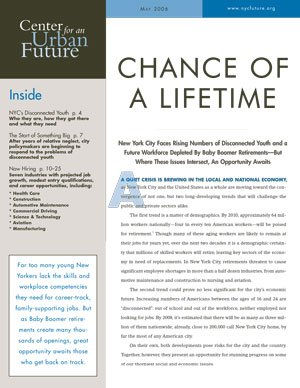In recent years, public and government attention has begun to focus on New York City's "disconnected youth"—young residents between the ages of 16 and 24 who are neither in school nor working. A January 2005 report by the Community Service Society of New York estimated that nearly 170,000 city residents met this description; other measures that include unemployed young people who are actively looking for work peg the number above 200,000.
As is true in general for those in poverty, disconnected youth are not a uniform group. Some became disconnected when they dropped out of high school; others might be struggling to raise their own children; still others contend with physical or mental health problems or other barriers to education or employment. Roughly half have at least completed high school or a GED.
Given the differences in life circumstances, educational attainment and work readiness among the disconnected, there is no single-bullet strategy for reconnecting them to school or work. For many, high school or GED completion is the goal; others, particularly those with high school degrees and family responsibilities, are more likely to be tracked toward job readiness and employment. Unfortunately, the combination of severely limited public resources and bureaucratic confusion among numerous city agencies and programs has led to very small numbers receiving services: a 2005 report from the Young Adult Task Force estimated that fewer than 10,000 disconnected young New Yorkers were reached by city programs.
The Mayor’s Commission for Economic Opportunity identified “young adults,” including disconnected youth, as one of three groups to target for poverty alleviation. Its recommendations include expanding the alternative-education programs and settings now offered by the Department of Education, such as the Learning to Work program and Young Adult Borough Centers; increasing and strengthening “school-community collaborations” that combine education and community service to help keep youth connected; making available more programs that help young adults transition from GED attainment to college; and focusing on the most vulnerable groups -- ex-offenders and young people aging out of foster care -- with a range of services.
My organization, the Center for an Urban Future, noted in a May 2006 report that the problem of disconnected youth also creates a tremendous opportunity for New York City. As pending Baby Boomer retirements create a new and urgent need for workers in key New York City industries like health care and construction, we can work with stakeholders in these and other industries to create training curricula and career tracks that can reconnect young New Yorkers to jobs that will benefit all city residents.



